Hao Shao
Deployable and Generalizable Motion Prediction: Taxonomy, Open Challenges and Future Directions
May 14, 2025



Abstract:Motion prediction, the anticipation of future agent states or scene evolution, is rooted in human cognition, bridging perception and decision-making. It enables intelligent systems, such as robots and self-driving cars, to act safely in dynamic, human-involved environments, and informs broader time-series reasoning challenges. With advances in methods, representations, and datasets, the field has seen rapid progress, reflected in quickly evolving benchmark results. Yet, when state-of-the-art methods are deployed in the real world, they often struggle to generalize to open-world conditions and fall short of deployment standards. This reveals a gap between research benchmarks, which are often idealized or ill-posed, and real-world complexity. To address this gap, this survey revisits the generalization and deployability of motion prediction models, with an emphasis on the applications of robotics, autonomous driving, and human motion. We first offer a comprehensive taxonomy of motion prediction methods, covering representations, modeling strategies, application domains, and evaluation protocols. We then study two key challenges: (1) how to push motion prediction models to be deployable to realistic deployment standards, where motion prediction does not act in a vacuum, but functions as one module of closed-loop autonomy stacks - it takes input from the localization and perception, and informs downstream planning and control. 2) how to generalize motion prediction models from limited seen scenarios/datasets to the open-world settings. Throughout the paper, we highlight critical open challenges to guide future work, aiming to recalibrate the community's efforts, fostering progress that is not only measurable but also meaningful for real-world applications.
Adaptive Markup Language Generation for Contextually-Grounded Visual Document Understanding
May 08, 2025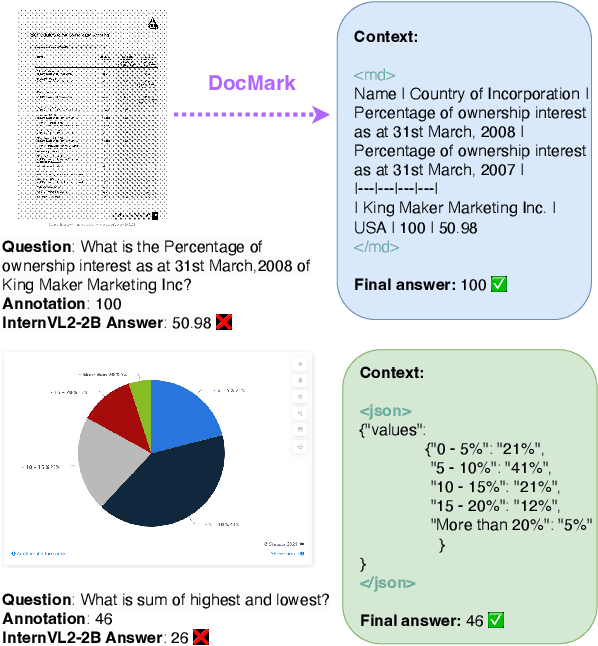

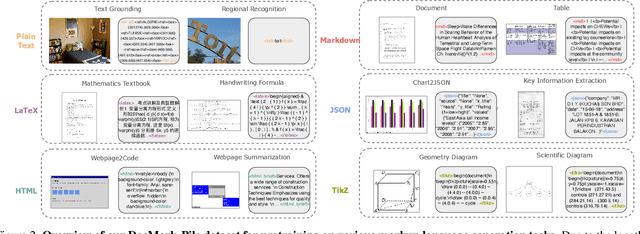
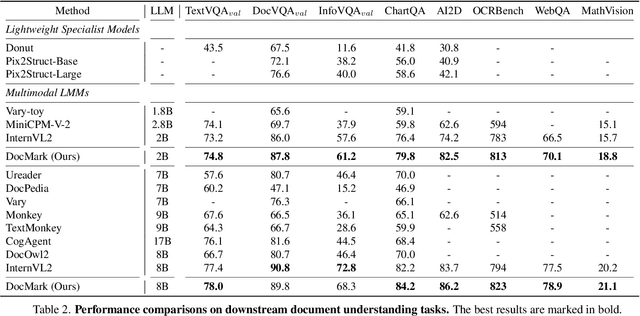
Abstract:Visual Document Understanding has become essential with the increase of text-rich visual content. This field poses significant challenges due to the need for effective integration of visual perception and textual comprehension, particularly across diverse document types with complex layouts. Moreover, existing fine-tuning datasets for this domain often fall short in providing the detailed contextual information for robust understanding, leading to hallucinations and limited comprehension of spatial relationships among visual elements. To address these challenges, we propose an innovative pipeline that utilizes adaptive generation of markup languages, such as Markdown, JSON, HTML, and TiKZ, to build highly structured document representations and deliver contextually-grounded responses. We introduce two fine-grained structured datasets: DocMark-Pile, comprising approximately 3.8M pretraining data pairs for document parsing, and DocMark-Instruct, featuring 624k fine-tuning data annotations for grounded instruction following. Extensive experiments demonstrate that our proposed model significantly outperforms existing state-of-theart MLLMs across a range of visual document understanding benchmarks, facilitating advanced reasoning and comprehension capabilities in complex visual scenarios. Our code and models are released at https://github. com/Euphoria16/DocMark.
High-Fidelity Diffusion Face Swapping with ID-Constrained Facial Conditioning
Mar 28, 2025Abstract:Face swapping aims to seamlessly transfer a source facial identity onto a target while preserving target attributes such as pose and expression. Diffusion models, known for their superior generative capabilities, have recently shown promise in advancing face-swapping quality. This paper addresses two key challenges in diffusion-based face swapping: the prioritized preservation of identity over target attributes and the inherent conflict between identity and attribute conditioning. To tackle these issues, we introduce an identity-constrained attribute-tuning framework for face swapping that first ensures identity preservation and then fine-tunes for attribute alignment, achieved through a decoupled condition injection. We further enhance fidelity by incorporating identity and adversarial losses in a post-training refinement stage. Our proposed identity-constrained diffusion-based face-swapping model outperforms existing methods in both qualitative and quantitative evaluations, demonstrating superior identity similarity and attribute consistency, achieving a new state-of-the-art performance in high-fidelity face swapping.
VividFace: A Diffusion-Based Hybrid Framework for High-Fidelity Video Face Swapping
Dec 15, 2024



Abstract:Video face swapping is becoming increasingly popular across various applications, yet existing methods primarily focus on static images and struggle with video face swapping because of temporal consistency and complex scenarios. In this paper, we present the first diffusion-based framework specifically designed for video face swapping. Our approach introduces a novel image-video hybrid training framework that leverages both abundant static image data and temporal video sequences, addressing the inherent limitations of video-only training. The framework incorporates a specially designed diffusion model coupled with a VidFaceVAE that effectively processes both types of data to better maintain temporal coherence of the generated videos. To further disentangle identity and pose features, we construct the Attribute-Identity Disentanglement Triplet (AIDT) Dataset, where each triplet has three face images, with two images sharing the same pose and two sharing the same identity. Enhanced with a comprehensive occlusion augmentation, this dataset also improves robustness against occlusions. Additionally, we integrate 3D reconstruction techniques as input conditioning to our network for handling large pose variations. Extensive experiments demonstrate that our framework achieves superior performance in identity preservation, temporal consistency, and visual quality compared to existing methods, while requiring fewer inference steps. Our approach effectively mitigates key challenges in video face swapping, including temporal flickering, identity preservation, and robustness to occlusions and pose variations.
EasyRef: Omni-Generalized Group Image Reference for Diffusion Models via Multimodal LLM
Dec 12, 2024



Abstract:Significant achievements in personalization of diffusion models have been witnessed. Conventional tuning-free methods mostly encode multiple reference images by averaging their image embeddings as the injection condition, but such an image-independent operation cannot perform interaction among images to capture consistent visual elements within multiple references. Although the tuning-based Low-Rank Adaptation (LoRA) can effectively extract consistent elements within multiple images through the training process, it necessitates specific finetuning for each distinct image group. This paper introduces EasyRef, a novel plug-and-play adaptation method that enables diffusion models to be conditioned on multiple reference images and the text prompt. To effectively exploit consistent visual elements within multiple images, we leverage the multi-image comprehension and instruction-following capabilities of the multimodal large language model (MLLM), prompting it to capture consistent visual elements based on the instruction. Besides, injecting the MLLM's representations into the diffusion process through adapters can easily generalize to unseen domains, mining the consistent visual elements within unseen data. To mitigate computational costs and enhance fine-grained detail preservation, we introduce an efficient reference aggregation strategy and a progressive training scheme. Finally, we introduce MRBench, a new multi-reference image generation benchmark. Experimental results demonstrate EasyRef surpasses both tuning-free methods like IP-Adapter and tuning-based methods like LoRA, achieving superior aesthetic quality and robust zero-shot generalization across diverse domains.
SmartPretrain: Model-Agnostic and Dataset-Agnostic Representation Learning for Motion Prediction
Oct 11, 2024



Abstract:Predicting the future motion of surrounding agents is essential for autonomous vehicles (AVs) to operate safely in dynamic, human-robot-mixed environments. However, the scarcity of large-scale driving datasets has hindered the development of robust and generalizable motion prediction models, limiting their ability to capture complex interactions and road geometries. Inspired by recent advances in natural language processing (NLP) and computer vision (CV), self-supervised learning (SSL) has gained significant attention in the motion prediction community for learning rich and transferable scene representations. Nonetheless, existing pre-training methods for motion prediction have largely focused on specific model architectures and single dataset, limiting their scalability and generalizability. To address these challenges, we propose SmartPretrain, a general and scalable SSL framework for motion prediction that is both model-agnostic and dataset-agnostic. Our approach integrates contrastive and reconstructive SSL, leveraging the strengths of both generative and discriminative paradigms to effectively represent spatiotemporal evolution and interactions without imposing architectural constraints. Additionally, SmartPretrain employs a dataset-agnostic scenario sampling strategy that integrates multiple datasets, enhancing data volume, diversity, and robustness. Extensive experiments on multiple datasets demonstrate that SmartPretrain consistently improves the performance of state-of-the-art prediction models across datasets, data splits and main metrics. For instance, SmartPretrain significantly reduces the MissRate of Forecast-MAE by 10.6%. These results highlight SmartPretrain's effectiveness as a unified, scalable solution for motion prediction, breaking free from the limitations of the small-data regime. Codes are available at https://github.com/youngzhou1999/SmartPretrain
MoVA: Adapting Mixture of Vision Experts to Multimodal Context
Apr 19, 2024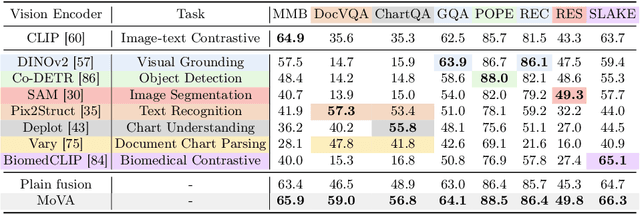
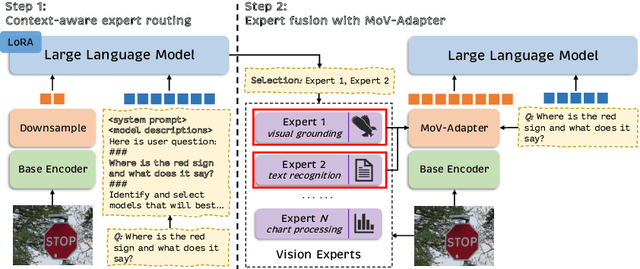
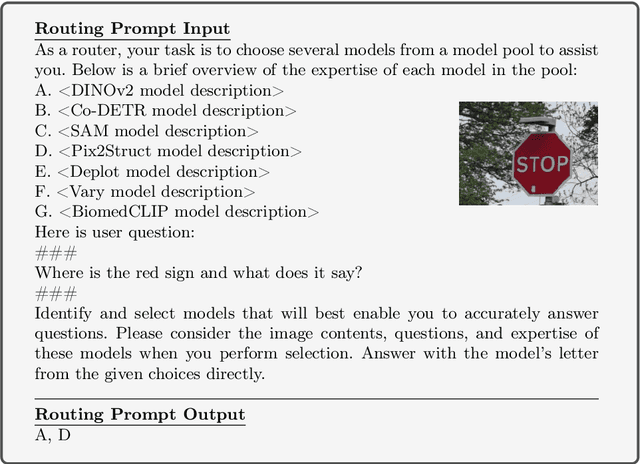
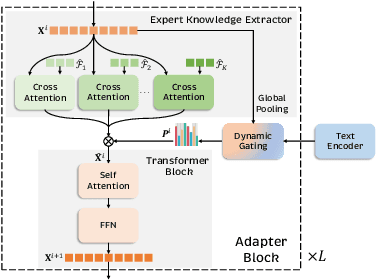
Abstract:As the key component in multimodal large language models (MLLMs), the ability of the visual encoder greatly affects MLLM's understanding on diverse image content. Although some large-scale pretrained vision encoders such as vision encoders in CLIP and DINOv2 have brought promising performance, we found that there is still no single vision encoder that can dominate various image content understanding, e.g., the CLIP vision encoder leads to outstanding results on general image understanding but poor performance on document or chart content. To alleviate the bias of CLIP vision encoder, we first delve into the inherent behavior of different pre-trained vision encoders and then propose the MoVA, a powerful and novel MLLM, adaptively routing and fusing task-specific vision experts with a coarse-to-fine mechanism. In the coarse-grained stage, we design a context-aware expert routing strategy to dynamically select the most suitable vision experts according to the user instruction, input image, and expertise of vision experts. This benefits from the powerful model function understanding ability of the large language model (LLM) equipped with expert-routing low-rank adaptation (LoRA). In the fine-grained stage, we elaborately conduct the mixture-of-vision-expert adapter (MoV-Adapter) to extract and fuse task-specific knowledge from various experts. This coarse-to-fine paradigm effectively leverages representations from experts based on multimodal context and model expertise, further enhancing the generalization ability. We conduct extensive experiments to evaluate the effectiveness of the proposed approach. Without any bells and whistles, MoVA can achieve significant performance gains over current state-of-the-art methods in a wide range of challenging multimodal benchmarks. Codes and models will be available at https://github.com/TempleX98/MoVA.
Visual CoT: Unleashing Chain-of-Thought Reasoning in Multi-Modal Language Models
Mar 25, 2024



Abstract:This paper presents Visual CoT, a novel pipeline that leverages the reasoning capabilities of multi-modal large language models (MLLMs) by incorporating visual Chain-of-Thought (CoT) reasoning. While MLLMs have shown promise in various visual tasks, they often lack interpretability and struggle with complex visual inputs. To address these challenges, we propose a multi-turn processing pipeline that dynamically focuses on visual inputs and provides interpretable thoughts. We collect and introduce the Visual CoT dataset comprising 373k question-answer pairs, annotated with intermediate bounding boxes highlighting key regions essential for answering the questions. Importantly, the introduced benchmark is capable of evaluating MLLMs in scenarios requiring specific local region identification. Extensive experiments demonstrate the effectiveness of our framework and shed light on better inference strategies. The Visual CoT dataset, benchmark, and pre-trained models are available to foster further research in this direction.
SmartRefine: A Scenario-Adaptive Refinement Framework for Efficient Motion Prediction
Mar 19, 2024



Abstract:Predicting the future motion of surrounding agents is essential for autonomous vehicles (AVs) to operate safely in dynamic, human-robot-mixed environments. Context information, such as road maps and surrounding agents' states, provides crucial geometric and semantic information for motion behavior prediction. To this end, recent works explore two-stage prediction frameworks where coarse trajectories are first proposed, and then used to select critical context information for trajectory refinement. However, they either incur a large amount of computation or bring limited improvement, if not both. In this paper, we introduce a novel scenario-adaptive refinement strategy, named SmartRefine, to refine prediction with minimal additional computation. Specifically, SmartRefine can comprehensively adapt refinement configurations based on each scenario's properties, and smartly chooses the number of refinement iterations by introducing a quality score to measure the prediction quality and remaining refinement potential of each scenario. SmartRefine is designed as a generic and flexible approach that can be seamlessly integrated into most state-of-the-art motion prediction models. Experiments on Argoverse (1 & 2) show that our method consistently improves the prediction accuracy of multiple state-of-the-art prediction models. Specifically, by adding SmartRefine to QCNet, we outperform all published ensemble-free works on the Argoverse 2 leaderboard (single agent track) at submission. Comprehensive studies are also conducted to ablate design choices and explore the mechanism behind multi-iteration refinement. Codes are available at https://github.com/opendilab/SmartRefine/
SPHINX-X: Scaling Data and Parameters for a Family of Multi-modal Large Language Models
Feb 08, 2024



Abstract:We propose SPHINX-X, an extensive Multimodality Large Language Model (MLLM) series developed upon SPHINX. To improve the architecture and training efficiency, we modify the SPHINX framework by removing redundant visual encoders, bypassing fully-padded sub-images with skip tokens, and simplifying multi-stage training into a one-stage all-in-one paradigm. To fully unleash the potential of MLLMs, we assemble a comprehensive multi-domain and multimodal dataset covering publicly available resources in language, vision, and vision-language tasks. We further enrich this collection with our curated OCR intensive and Set-of-Mark datasets, extending the diversity and generality. By training over different base LLMs including TinyLlama1.1B, InternLM2-7B, LLaMA2-13B, and Mixtral8x7B, we obtain a spectrum of MLLMs that vary in parameter size and multilingual capabilities. Comprehensive benchmarking reveals a strong correlation between the multi-modal performance with the data and parameter scales. Code and models are released at https://github.com/Alpha-VLLM/LLaMA2-Accessory
 Add to Chrome
Add to Chrome Add to Firefox
Add to Firefox Add to Edge
Add to Edge